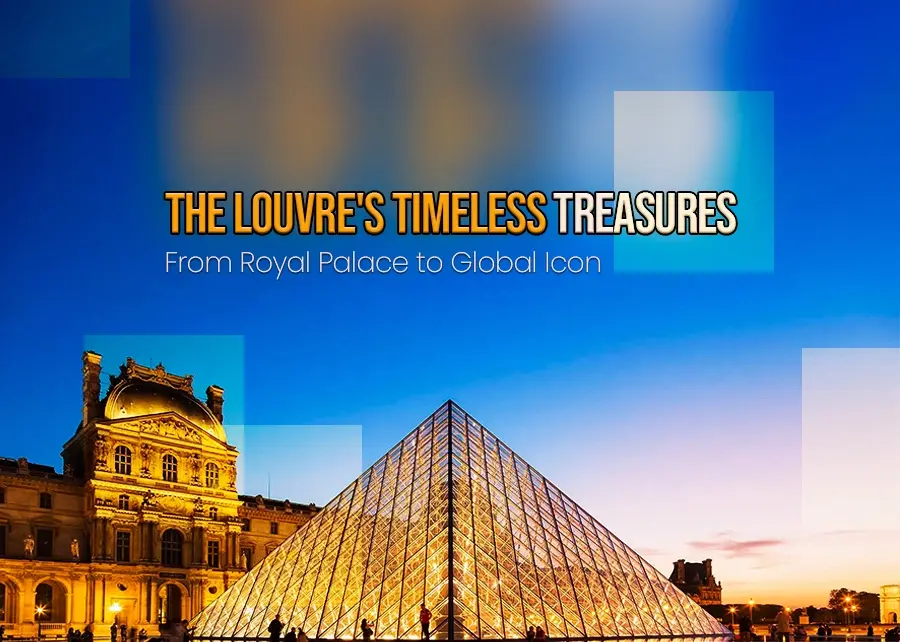The Louvre Museum, also known as the Louvre, is a place where art, culture and history meet, providing visitors with an unforgettable experience. Located in the heart of Paris, France, this extraordinary institution is much more than a museum; It symbolizes human creativity and success. In this article, we will walk the sacred streets of the Louvre and examine the importance, history and cultural significance of experiencing the texture of Paris. Explore Louvre Museum book your ticket now.
Table of Contents
Louvre Museum History
Ancient Origins
To understand the best aspects of visiting the Louvre, we must look at the history of that time. The museum’s glorious history, spanning centuries, bears witness to the rise and fall of kings and civilizations. Its origins date back to King II at the end of the 12th century. It dates back to the medieval castle built by Philip II. Built to protect Paris in times of crisis, the castle formed the basis of the final Louvre.
Royal Residency
The Louvre has changed a lot over the years. From a defensive fortress, it grew into a kingly one in the reign of King Francis I in the 16th century. The Louvre became a symbol of the king’s power and prestige, hosting lavish ceremonies and a testament to the leadership of the ruling elite.
France’s Revolution
During the French Revolution, the Louvre was blown away by the wind. Revolutionary. The palace was redesigned to reflect changes in accessibility and public ownership of the property. The Louvre opened as a public museum in 1793, which left its mark on the museum’s history. The decision to make the Louvre the people’s repository of art laid the foundation for its future as a world-wide beacon of culture.
Architectural Evolution
The brilliance of the Louvre lies not only in its history but also in the architectural evolution that has shaped it. Architectural changes and modifications over the centuries have added to the complexity and beauty of the structure. Architectural influences, from Francis I’s Renaissance expansion to the modern glass pyramids designed by IM Pei in the 20th century, have contributed to the museum’s beauty and international appeal.
Cultural Icon
Today, the Louvre has become a cultural icon, a testament to the permanence of art and history. Its rich collection spans thousands of years and includes treasures from many cultures. The museum’s corridors are filled with the footprints of countless visitors who admired masterpieces such as the Mona Lisa, the Venus de Milo and the Wings of the Victory of Samothrace. The Louvre’s role as guardian of human art has earned it the status of one of the world’s finest cultural institutions.
Global Influence
The Louvre’s influence extends far beyond the borders of France. As the world’s largest art museum and historical monument, it welcomes millions of visitors every year. The Louvre has become a symbol of cultural exchange, promoting appreciation of art and history around the world. His diverse and engaging productions continue to inspire, educate and engage audiences around the world.
What Did the Louvre Look Like Before It Became a Museum?
Before the Louvre became a museum, it was a bastion of royal power and magnificence. It was the residence of French leaders and showcased their wealth and power. Join us as we retrace the steps of history and uncover the Louvre’s past.
Architecture and setting
The beautiful architecture of the Louvre is a tribute to human creativity. Pei’s famous glass pyramid entrance has attracted the attention of people from all over the world. The Louvre is an art in itself with its beautiful architecture. We will also visit the museum’s beautiful courtyard, which provides paradise and peace from bustling Paris.
Louvre Museum
Art Collections at the Louvre
The Louvre building is a rich collection of my art spanning civilizations and ages. The rich and diverse art collection includes more than 380,000 works, each with a story. From the mysterious smile of the Mona Lisa to the timeless beauty of the Venus de Milo, we will focus on some of the most beautiful artists and performers of the home collection. We will also uncover the entire museum’s beautiful collection by exploring various sections, from paintings to sculptures to decorative arts.
What is the Louvre Museum’s significance?
We then explore the significant worldwide impact of the Louvre’s artistic and cultural heritage and uncover the mystery behind its global recognition. With its mysterious face, the Mona Lisa points to the Louver’s enduring appeal, but there is more to its fame than meets the eye.
Where can I find the Mona Lisa in the Louvre?
Enter the world of the Louvre Mona Lisa, perhaps the Louver’s most famous tenant. We will take you to Leonardo da Vinci’s masterpiece and reveal the true location of the mysterious painting in this magnificent museum. For more information, visit: Tours Travel Finder
Experience of the Visitor
We provide important visitor information and helpful tips to help you plan your museum tour. We help you make the most of your visit to the Louvre. Learn about services and places that can enhance your visit, such as charming cafes, souvenir shops and resorts where you can reflect on the beauty you’ve seen.
Cultural and Educational Programs
The Louvre continues its impact with many educational programs, interesting discussions and exciting conferences, as well as its special collections. We will look at how museums support greater understanding of art and culture and act as global ambassadors of creative appreciation.
Efforts to Protect the Environment
The purpose of the Louvre is to preserve and preserve beautiful paintings. We take you behind the scenes to learn about the passion, technology, artistic techniques and care that ensures these treasures are preserved for future generations.
Disputes and Challenges
The Louvre, like other museums, has its own problems and problems. We will examine concerns regarding the return of art, highlighting conflicts and legal issues. We will also discuss important issues such as the density and security of museums where experts are hosted.
What is the Louvre Museum famous for?
- Mona Lisa: The Louvre is famous for Leonardo da Vinci’s iconic ‘Mona Lisa‘ painting with a mysterious smile that has captivated audiences for centuries.
- Venus de Milo: Another highlight is the ancient Greek statue ‘Venus de Milo‘, celebrated for its graceful depiction of female beauty and classical aesthetics.
- Winged Victory of Samothrace: The museum is famous for a remarkable Hellenistic sculpture known as the “Winged Victory of Samothrace“, which represents the goddess Nike and is admired for its dynamic composition.
- Rich Art Collections: The Louvre boasts a vast and diverse art collection spanning civilizations and eras, including paintings, sculptures, decorative arts and artifacts from various cultures around the world.
- Architectural Splendor: From its medieval beginnings to the modern glass pyramid designed by I.M. Pei, the Louvre’s architectural significance is a crucial aspect of its fame, and represents a blend of historic and contemporary design.
- Cultural icon: As a symbol of French culture and history, the Louvre is recognized worldwide as a cultural icon, attracting millions of visitors each year.
- Largest art museum in the world: It is the largest art museum in the world with an extensive exhibition space of approximately 782,910 square feet (72,735 square meters).
- Egyptian Treasures: The Louvre is celebrated for its extensive collection of Egyptian artifacts, including the Rosetta Stone, a key element in deciphering hieroglyphics.
- Global Influence: The Louvre’s influence extends beyond France, acting as a global ambassador for art and culture, promoting international recognition and understanding.
- Cultural and educational programs: In addition to its collections, the Louvre is known for its educational initiatives, seminars and lectures that contribute to a better understanding of art and culture.
- Constant innovation: The museum is recognized for its efforts to preserve and protect works of art through advanced technology, precise restoration processes and a commitment to environmental sustainability.
- Symbol of Paris: The Louvre symbolizes Paris, adding glamor to the city and serving as a cultural and economic powerhouse with enormous influence.
5 Fascinating Louvre Facts
As a leaving gift, here are five fascinating and lesser-known Louvre facts:
- As a going-away gift, here are five fascinating and lesser-known facts about the Louvre:
- Louvre Underground City: Beneath the museum is an underground complex that includes a shopping mall, food court and even a multi-storey car park – a bustling metropolis hidden beneath the surface.
- The Louvre was once surrounded by a protective moat, which was subsequently filled in and turned into a gallery displaying European sculptures.
- Egyptian Treasures: The Louvre has one of the most extensive collections of Egyptian artifacts in the world, including the famous Rosetta Stone, which is essential for deciphering hieroglyphics.
- The world’s biggest art heist: The painting “Mona Lisa” was taken from the Louvre in 1956, leading to the most significant art theft in history. It was restored two years later in Italy, making the Mona Lisa the world’s most famous painting.
- The Louvre is the most visited museum in the world and the most important exhibition space, covering approximately 782,910 square feet (72,735 square meters).
Conclusion
As we conclude our tour of the Louvre, we reflect on this renowned institution’s historical and cultural significance. We conclude with last thoughts on the Louvre Museum’s enduring legacy as an invaluable treasure trove of human invention and a tribute to Paris, France’s eternal quest for art and culture.
What is the Louvre Museum, and where is it located?
One of the largest and most renowned art museums in the world is the Louvre Museum, often known as the Musée du Louvre. It is situated on the Seine River’s right bank in Paris, France.
Are there educational programs or events for visitors at the Louvre?
For tourists of all ages, the Louvre offers events, workshops, and educational programmes. These include talks, guided tours, and hands-on activities meant to boost art appreciation and expertise.
Are there temporary exhibitions at the Louvre in 2024?
The Louvre regularly hosts temporary exhibitions that complement its permanent collection.
Are there specific periods or styles emphasized in the Louvre’s collection?
The collection of the Louvre is large and comprises objects from many global cultures, Egyptian antiquities, Greek and Roman artifacts and Renaissance works of art. It offers an extensive examination of art history.
Related Post:
- How many steps in the Eiffel tower?
- Magic Nights at Casa Batllo Rooftop
- Exclusive Rijksmuseum Vermeer Tickets 2023
- Exciting Audio Guide Colosseum Rome Tour in 2023
- The Arc de Triomphe Tour Experience: From Victory to Vision




